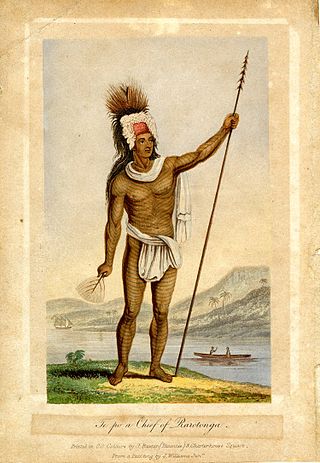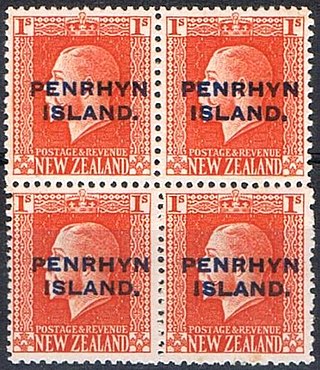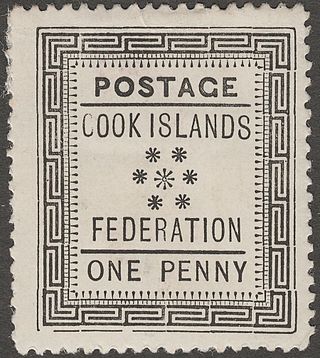
The Cook Islands are named after Captain James Cook, who visited the islands in 1773 and 1777, although Spanish navigator Alvaro de Mendaña was the first European to reach the islands in 1595. The Cook Islands became aligned to the United Kingdom in 1890, largely because of the fear of British residents that France might occupy the islands as it already had Tahiti.
The history of Niue is the history of the area and people of Niue, including its indigenous Polynesian societies. Niue was first settled by Polynesian sailors from Samoa in around 900 AD. Further settlers arrived from Tonga in the 16th century.

A postmark is a postal marking made on an envelope, parcel, postcard or the like, indicating the place, date and time that the item was delivered into the care of a postal service, or sometimes indicating where and when received or in transit. Modern postmarks are often applied simultaneously with the cancellation or killer that marks postage stamps as having been used. Sometimes a postmark alone is used to cancel stamps, and the two terms are often used interchangeably. Postmarks may be applied by handstamp or machine, using methods such as rollers or inkjets, while digital postmarks are a recent innovation.

This is an overview of the postage stamps and postal history of Australia.

The postage stamps and postal history of Aitutaki describes the stamps used in Aitutaki.
Each "article" in this category is in fact a collection of entries about several stamp issuers, presented in alphabetical order. The entries themselves are formulated on the micro model and so provide summary information about all known issuers.

The first Stanley Gibbons stamp catalogue was a penny price list issued in November 1865 and reissued at monthly intervals for the next 14 years. The company produces numerous catalogues covering different countries, regions and specialisms; many of them are reissued annually. The catalogues list all known adhesive postage stamp issues and include prices for used and unused stamps.
A semi-postal stamp or semipostal stamp, also known as a charity stamp, is a postage stamp issued to raise money for a particular purpose and sold at a premium over the postal value. Typically the stamp shows two denominations separated by a plus sign, but in many cases the only denomination shown is for the postage rate, and the postal customer simply pays the higher price when purchasing the stamps.

This is a survey of the postage stamps and postal history of Tibet.

The postage stamps and postal history of Christmas Island, in the Indian Ocean, was linked to its original economic situation until 1993. Mainly ruled by a phosphate production commission, the island was part of the British Straits Settlements colony from 1901 to 1942, then of Singapore from 1946 to 1958. Although it was placed under Australian control in 1958, the island remained postally and philatelically independent until 1993 when Australia Post became the island's postal operator.

The postage stamps and postal history of Norfolk Island depended on Australia until 1947, when the island, an Australian territory since 1914, received its own stamps and postal autonomy.

The postal history of the Pitcairn Islands began with letters being sent without postage stamps, as none were available on Pitcairn. In 1921, the United Kingdom and New Zealand formally agreed upon a system to handle post from the island, but this arrangement was ended in 1926. In 1927, stamps from New Zealand were introduced. To improve the revenue generation of the colony, the British government established an official post office on the island in 1940. The opening of this post office saw the issuance of the first set of Pitcairn Islands stamps.

This is a survey of the postage stamps and postal history of Gibraltar.

This is a survey of the postage stamps and postal history of Tuvalu.

This is a survey of the postage stamps and postal history of Penrhyn.

This is a survey of the postage stamps and postal history of the Cook Islands.
Reginald George James Berry was a New Zealand artist, noted for creating a large number of postage stamp and coin designs. He was born in London in 1906, and emigrated to New Zealand in 1925. He went on to become a commercial artist at a Wellington advertising agency, and in 1932 became a freelance artist. His work included book covers and illustrations, but is most famous for more than 1,000 stamp, coin and medal designs.

A postal fiscal is a revenue stamp that has been authorised for postal use. Postal fiscals may arise because there is a shortage of postage stamps for a country or out of economy to use up obsolete or excess stocks of revenue stamps. Postal fiscals are to be distinguished from stamps marked "Postage and Revenue" which were always intended for either use, or revenue stamps used postally by accident or because local postal regulations did not prohibit such use. Postal fiscal status may usually only be identified from the cancels on used stamps or where the stamp is found on cover.

The Church of Jesus Christ of Latter-day Saints in the Cook Islands refers to the Church of Jesus Christ of Latter-day Saints and its members in Cook Islands. The first regularly held Sunday meetings began in 1943. In 2022, there were 1,862 members in 5 congregations.
















